What are affiliate links? All you need to know!
-
Abdul Wadood
What are affiliate links? Are you interested to learn about them?
If YES, you have arrived at the right place! In this blog, I have provided a detailed explanation about affiliate links, and I have also given tips on using them.
This blog will be pretty long because as it’s detailed. I recommend you to read the entire blog as it would benefit you. If you’re in a hurry, feel free to skip to the topic you want to learn.
Topics to be discussed in this blog:
Introduction
First, what is affiliate marketing?
In simple terms, affiliate marketing is a business model where you sell a product or service for a commission.
Now, you might wonder, who will provide the commission?
Good question!
You will receive the commission from the companies with whom you partner as an affiliate. Nowadays, several companies have affiliate programs, and it’s pretty easy to sign up for them.
Once you decide the product you want to promote, join as an affiliate for the companies selling those products.
Ok! Now, you have joined an affiliate program.
Next, how will the companies know which affiliate bought them a particular sale? Here’s where affiliate links come into play.
When affiliates join an affiliate program, the company provides a unique link with the referrer’s ID. These links are called affiliate links.
Here’s how an affiliate link looks.

When a customer clicks on this link, he will reach the merchant’s website. If he purchases a product from the merchant, the affiliate marketer will receive a commission.
How to use affiliate links?
I hope that you have got a clear idea about affiliate links. Now, we will get into the topic of using the affiliate links.
1. Use affiliate links in the form of text
I have a question for you. As a user, will you click on the first or the second link?
Of course, the first one. Am I right?
The first link gives a clear idea to people of where the link will take them. However, the second link looks unprofessional, and some may even see it as spam.
Here’s an example of a text-based affiliate link from one of my blogs.
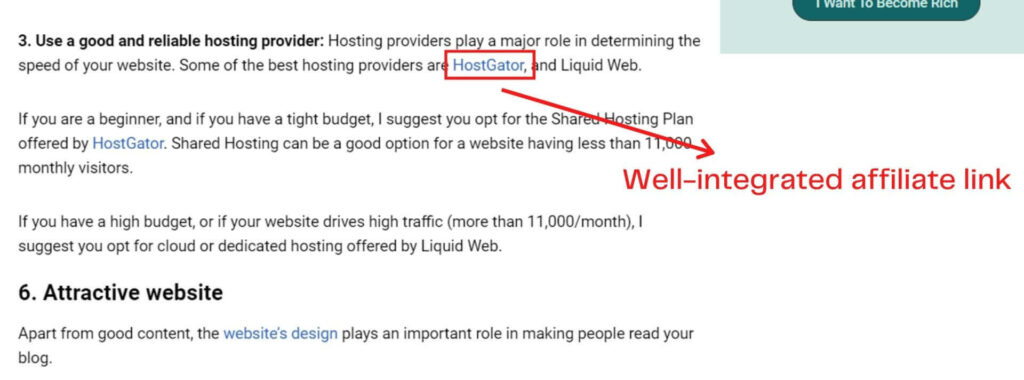
As you can see, the affiliate links are well-integrated with other contexts.
2. Don’t overuse affiliate links
Many people tend to overuse affiliate links in their blog or other marketing channels.
I recently published a 3000+ words blog about content marketing. Guess how many affiliate links I included in the blog?
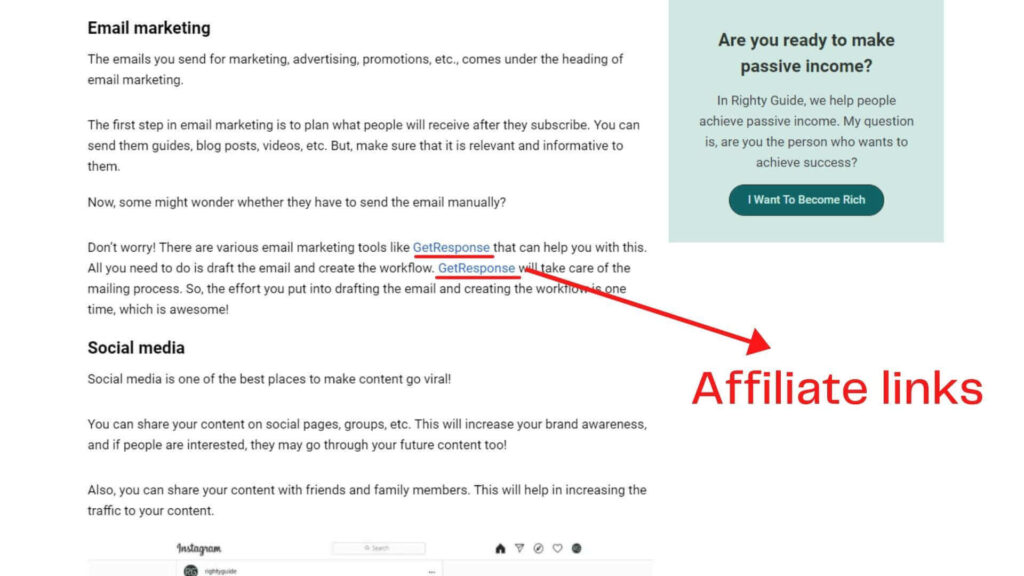
Just 5. Aren’t you shocked?
The reason for including a low number of affiliate links is simple.
Your primary motive behind writing a blog or anything similar should be providing value to people. If your content is high-quality, you can easily make affiliate sales, even if you include fewer affiliate links.
3. Make the affiliate links as nofollow
It’s not a must to make an affiliate link as nofollow. But, it’s highly recommended.
Before getting into details, I will quickly explain with an example what nofollow links are.
When an authoritative website links to your web page, the domain authority of your website will increase. This helps your website to rank higher on the search results.
However, if someone provides you a nofollow link, the domain authority will not increase. In other words, the link equity (link juice) won’t flow from their website to your website.
All links are dofollow by default. However, it’s pretty easy to convert them into nofollow links.
When you add the rel=”nofollow” tag to a link, it becomes nofollow.
Ok.
When you add the nofollow tag to your affiliate link, the link juice won’t be transferred to your merchant’s website.
The reason for doing this is simple.
If you place too many dofollow promotional links, the bots in Google may think you’re getting paid by your merchant for linking their website. As a result, Google may penalize you by decreasing your website’s ranking.
Here’s an example of a nofollow affiliate link.
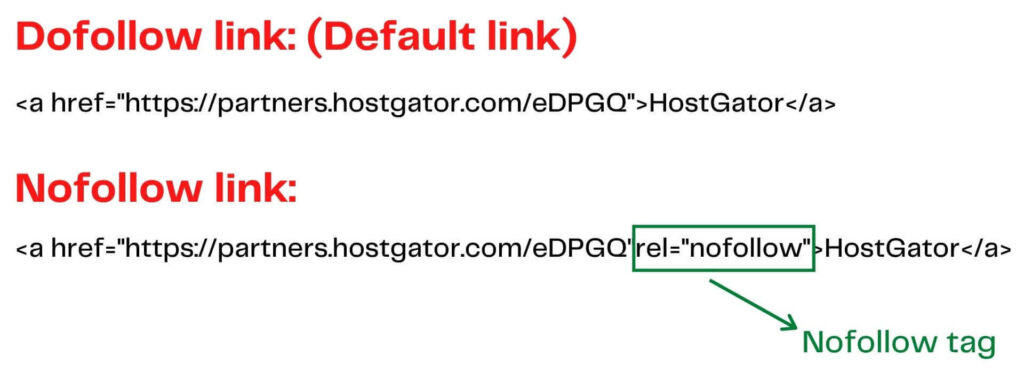
4. Disclose the affiliate links
To comply with the guidelines of the FTC (Federal Trade Commission, USA), you must disclose the affiliate links.
If you promote the products of US-based companies, and your marketing channels (blogs, social media, etc.) receive traffic from the United States, you should disclose the affiliate links.
Also, the affiliate disclosure should be clearly visible to the people. I suggest adding the affiliate disclosure at the top to make it visible.
Moreover, this blog contains affiliate links, and I have disclosed them at the top of the page.
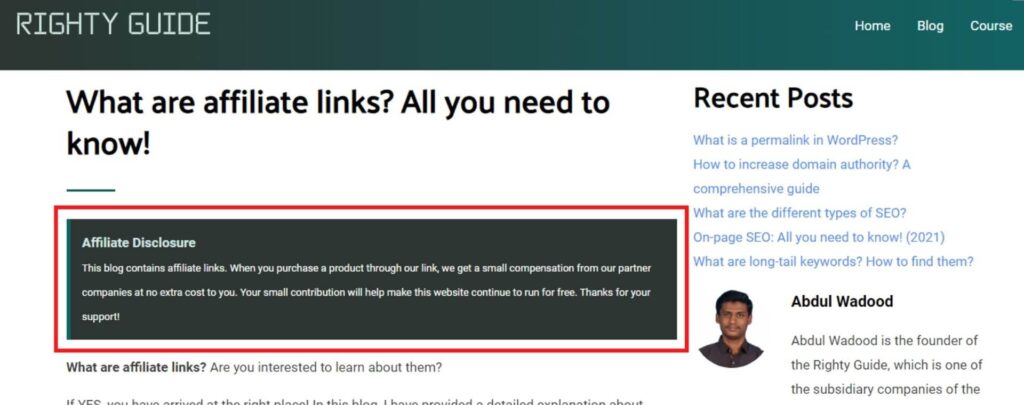
Note: It takes a lot of time and effort to offer high-quality materials to people for free. As an appreciation, it would be great if you use the affiliate links in this blog to purchase web hosting, email marketing tool, or keyword research tool. Thank you!
Best ways to promote affiliate links
You can promote affiliate links in various ways. I have explained them below.
1. Website
Websites are one of the best places to promote an affiliate product.
For instance, say that you promote smartphones. In this case, you can write detailed reviews about them on your website and promote the affiliate links. You can also write a comparison blog and promote the affiliate links.
Nowadays, creating a website has become a lot easier compared to the past years — thanks to WordPress.
Moreover, the prices for web hosting have decreased, which makes creating a website more affordable.
You can buy the hosting from established web hosting companies like HostGator.
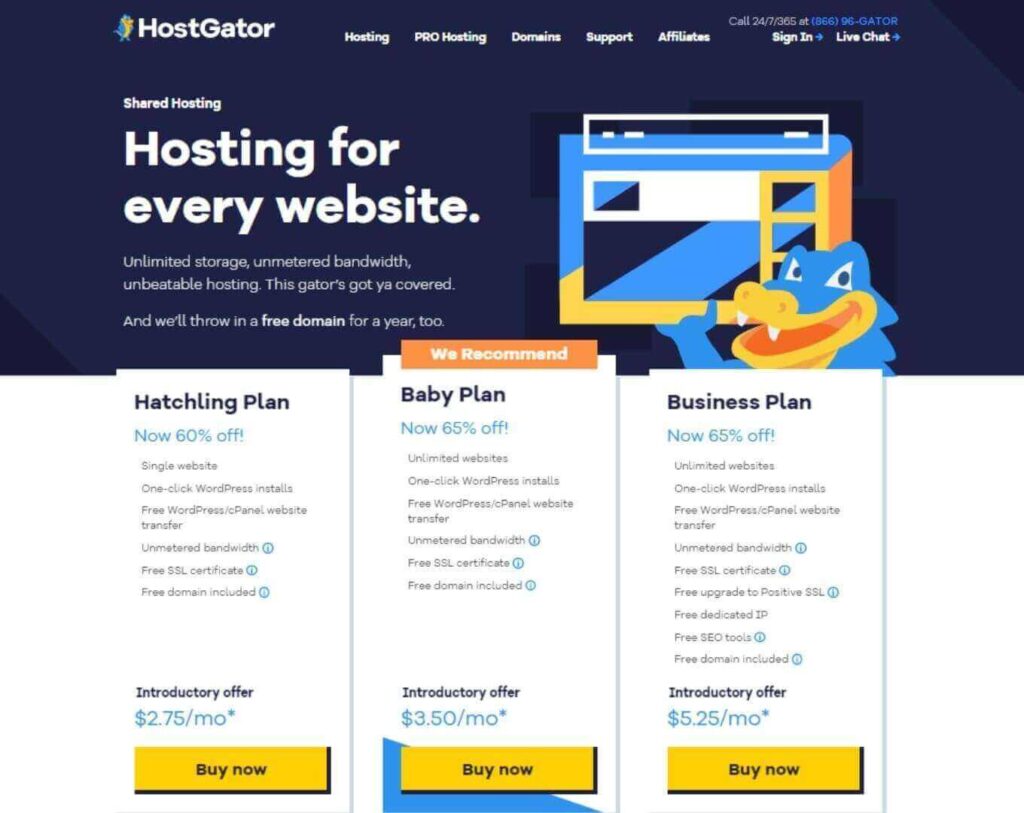
As you can see in the image, established web hosting companies like HostGator provide affordable web hosting solutions. Keep in mind that the pricing will vary depending on your subscription duration.
Ok.
Once you install WordPress on your website, you can choose a theme and start writing blogs.
Creating a website is that simple!
Now, once you publish a blog, you should drive the traffic to it. Ranking high on the Google search results plays a significant role in increasing the traffic to your blog.
Once you install WordPress on your website, you can choose a theme and start writing blogs.
Creating a website is that simple!
Now, once you publish a blog, you should drive the traffic to it. Ranking high on the Google search results plays a significant role in increasing the traffic to your blog.
Here are some tips to achieve higher rankings in the search results.
- The first and the most obvious way to rank higher in the search results is by publishing high-quality content.
- The loading speed of your web page plays a significant role in determining the rank of your website in the search results. If your website loads slow, people will leave the site, which increases the bounce rate. A high bounce rate can affect the SEO performance of your website.
- Building backlinks to your website can help to increase the domain authority, which will, in turn, increase the rankings.
- The blogs you write should be keyword optimized. You can use tools like Wordtracker to perform keyword research.
- You should provide a good user experience to people because it can make them stay on your website for a longer duration.
- Make your website mobile-friendly. Nowadays, many people browse the internet on their smartphones. If you don’t optimize your website for smartphones, you may lose a lot of potential customers.
2. Email marketing
Email marketing is one of the most effective forms of digital marketing, with a high Return on Investment (ROI).
Similarly, email marketing is one of the best places to promote affiliate links and make affiliate sales.
Now, some may doubt whether we should mail the subscribers manually?
Don’t worry! The world has advanced, and so did email marketing.
All you have to do is sign up for an email marketing software like GetResponse. Once you sign up, you can set up either autoresponder sales funnel or automation sales funnel to email the subscribers automatically when they subscribe.
Now you are good to go!
If you want to make affiliate sales, you should send emails that are beneficial to people. You can email your subscribers free e-books, courses, etc., that contain affiliate links. Though creating info-products can be difficult, trust me, you can get many affiliate sales through them.
The following are the best ways to collect the email addresses of people.
Ways to collect email address
- You can collect email addresses through an opt-in form. The sidebars of a website are one of the best places to add an opt-in form.

- You can collect email addresses through pop-ups. Many websites started to utilize this strategy as it’s effective.
- If you sell a product on your website, you can capture people’s email addresses during checkout. You can use their email address to upsell your products or notify them about a new product launch.
3. Social media
As you all already know, people spend a lot of time on social media.
You can create a YouTube channel, Facebook page, Instagram page, etc., and publish content related to your niche.
For instance, if you have a YouTube channel, you can publish videos related to your niche and promote the affiliate links on the description box.
Moreover, you can use social media to increase traffic to your blogs, increase your email subscribers, etc.
Conclusion
I hope this blog gave you a clear idea about affiliate links, how to use them, and the best ways to promote them.
Let’s now go through a quick recap of this blog.
- Affiliate links are unique tracking links that a company provides when you partner with them as an affiliate.
- Disclose the affiliate links to comply with the guidelines of the FTC (Federal Trade Commission, USA).
- Website, email marketing, and social media are some of the best ways to promote affiliate links.
- Wherever possible, make the affiliate links as nofollow.
This is the end of this blog. We will meet soon in the next one, take care!
If you have any questions, let’s discuss them in the comment section below.
